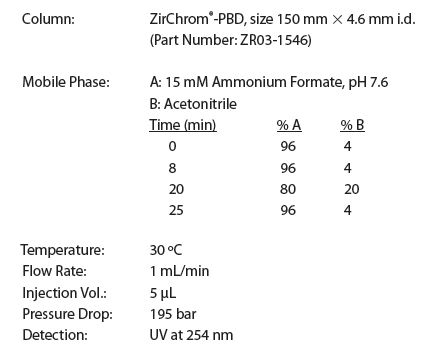Separation of Benzimidazoles and Derivatives in Anti-Parasitic Drugs
The Application Notebook
This multicomponent analysis of anti-parasitic drugs achieves baseline resolution of six closely related compounds in under 20 min using gradient elution and the unique selectivity of ZirChrom®-PBD.
Benzimidazoles are a large class of pharmaceuticals used in animal production with a broad spectrum of activity against roundworms (nematodes) (1). The longer half-life of oxfendazole and fenbendazole, due to their slow metabolization, allows these compounds to be more effective but also raises the concern of residues in the final food products. Here we present a gradient method of six closely related anti-parasitic pharmaceuticals.
Experimental
A mixture of six anti-parasitic pharmaceuticals was separated at 30 °C using a ZirChrom®-PBD column. Samples were 1 mg/mL and were in acetonitrile with the exception of benzthiazuron which was in methanol. The separation conditions were as follows:

This method can be tailored to your specific application needs. ZirChrom technical support can help to optimize and transfer this method to your site. Please contact ZirChrom technical support at 1-866-STABLE-1 or support@zirchrom.com for details.

Figure 1: Separation of six benzimidazoles.
ZirChrom phases offer unique selectivity, high efficiency, and excellent chemical and thermal stability.
Visit www.zirchrom.com for more application notes using ultra-stable, high efficiency ZirChrom columns.
Reference
(1) http://www.merckvetmanual.com/mvm/pharmacology/anthelmintics/benzimidazoles.html

ZirChrom Separations, Inc.
617 Pierce Street, Anoka, MN 55303
tel. 1-866-STABLE-1, email: support@zirchrom.com
Website: www.zirchrom.com

SEC-MALS of Antibody Therapeutics—A Robust Method for In-Depth Sample Characterization
June 1st 2022Monoclonal antibodies (mAbs) are effective therapeutics for cancers, auto-immune diseases, viral infections, and other diseases. Recent developments in antibody therapeutics aim to add more specific binding regions (bi- and multi-specificity) to increase their effectiveness and/or to downsize the molecule to the specific binding regions (for example, scFv or Fab fragment) to achieve better penetration of the tissue. As the molecule gets more complex, the possible high and low molecular weight (H/LMW) impurities become more complex, too. In order to accurately analyze the various species, more advanced detection than ultraviolet (UV) is required to characterize a mAb sample.

.png&w=3840&q=75)

.png&w=3840&q=75)



.png&w=3840&q=75)



.png&w=3840&q=75)










